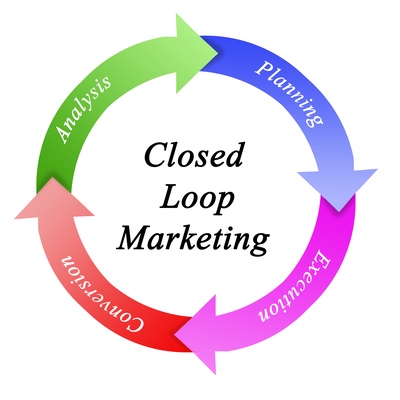Many companies develop the marketing strategy for their online store with the help of classic models such as AIDA or the sales funnel. These have a clearly defined beginning and end. However, it is better to think in a kind of cycle. Welcome to the world of Closed Loop Marketing.
Closed Loop Marketing: What is this?
Closed Loop Marketing is about learning from important insights and applying them holistically. Not only can you improve your marketing, PR and sales activities, but you can also provide other departments such as product development, product management and customer care with new knowledge about your customers.
In other words, Closed Loop Marketing aims to break down the "silos" that tend to form in companies. Marketing, sales, support and co. should be in constant communication to benefit from each other. The basis for this is customer data and analyses that are collected together along the customer journey.
What does this mean in concrete terms?
In theory, Closed Loop Marketing works quite simply: you plan a comprehensive marketing campaign, which naturally also includes areas such as press relations and sales measures. After planning, you implement the measures together with your colleagues and external supporters (e.g. advertising agencies). At the same time, you try to collect as much data and feedback as possible - within the legal framework of the General Data Protection Regulation, of course.
You evaluate the data and information collected to gain important insights. These are, for example:
- Which measures (Banner ads, Facebook ads, etc.) worked particularly well and which did not?
- How did the prospective customers behave on your online store? Where did they click, how long did they stay?
- How many online store visitors were converted into paying customers?
- What technical or logistical problems did you encounter?
- What praise and criticism did the customer service team receive?
You share the analyses and your conclusions with all relevant people and departments in your company. You then jointly develop new, optimized marketing campaigns in which you do not repeat the "mistakes" of the previous ones.
You apply this procedure of planning, implementing, learning and optimizing on an ongoing basis. This creates a cycle, the Closed Marketing Loop, which is based on the Build-Measure-Learn-Circle of the Lean Startup method.


What is so special about Closed Loop Marketing?
In the marketing and sales process, your company has various touchpoints at which contact is made with (potential) customers. These include, for example, your company blog, your Instagram channel or an inquiry by email. At each touchpoint, you should collect crucial information about your target group to gain deeper insights into the needs and preferences of your prospects and buyers.
Traditionally, the various marketing channels, such as the social media and sales teams, operate in isolation from each other. This creates the so-called silos. An exchange of collected data and insights between these channels rarely if ever takes place. This blocks the ability to effectively optimize all marketing activities and leaves numerous sales opportunities untapped. In addition, other areas of the company, such as product development or customer service, gain little insight into what makes the target groups "tick".
Closed Loop Marketing aims to close this gap. Here, the various teams and departments work more closely together by sharing all the customer information and analyses collected and constantly exchanging information. This enables continuous optimization of strategies, always with a focus on the actual needs and wishes of the target groups. The result is significantly improved customer centricity and therefore a better e-commerce result.
Closed Loop for replication: an example
Let's move on from theory to practical implementation. This is how you can apply Closed Loop Marketing:
- You are planning an Instagram campaign to increase sales in your online store. Beforehand, you define the target groups to be addressed and relevant key figures that you can use to measure your success.
- Ideally, different departments should come together - for example, product development, marketing, sales and support - so that everyone can formulate their requirements and contribute their expertise.
- Then implement the campaign and collect as much data as possible together. This means, among other things, determining views, clicks, page impressions, dwell time, shopping cart values, cart abandonment rate and the number of support tickets.
- After the measures, look at the data collected and the feedback in detail. Try to learn as much as possible from the information and draw conclusions.
- Use the findings to improve your upcoming marketing campaigns and to optimize downstream processes.
- Insights can be, for example:
- The advertising materials were not attractive enough > Your graphic designer needs to come up with new motifs
- Your online store had technical problems, resulting in abandoned purchases > Your IT service provider has to fix the problems
- Your products don't have the promised quality, which is why customers are dissatisfied > Development needs to improve the products
These are the advantages of the new procedure
If you use Closed Loop Marketing in your company, this means three things:
- You are not thinking in terms of completed projects. Rather, you are constantly learning more about your customers and responding better and better to their wishes and needs. In other words, you are becoming agile.
- You work in a large team that pulls together. This team does not end at the office walls of the marketing department but extends across large parts of your company. You work together to advance your products and therefore your company. This strengthens cohesion and makes it easier to achieve the overarching goals.
- You work digitally. Because only with online marketing and digital tools the relevant figures and data can be collected in the depth and accuracy that you need for e-commerce.
Summary
Do you have the feeling that your company is losing contact with its customers and that your products are not being as well received on the market as you had hoped? Do different departments in your company no longer work closely together, for example because your company has grown rapidly? Then you should consider introducing Closed Loop Marketing.








